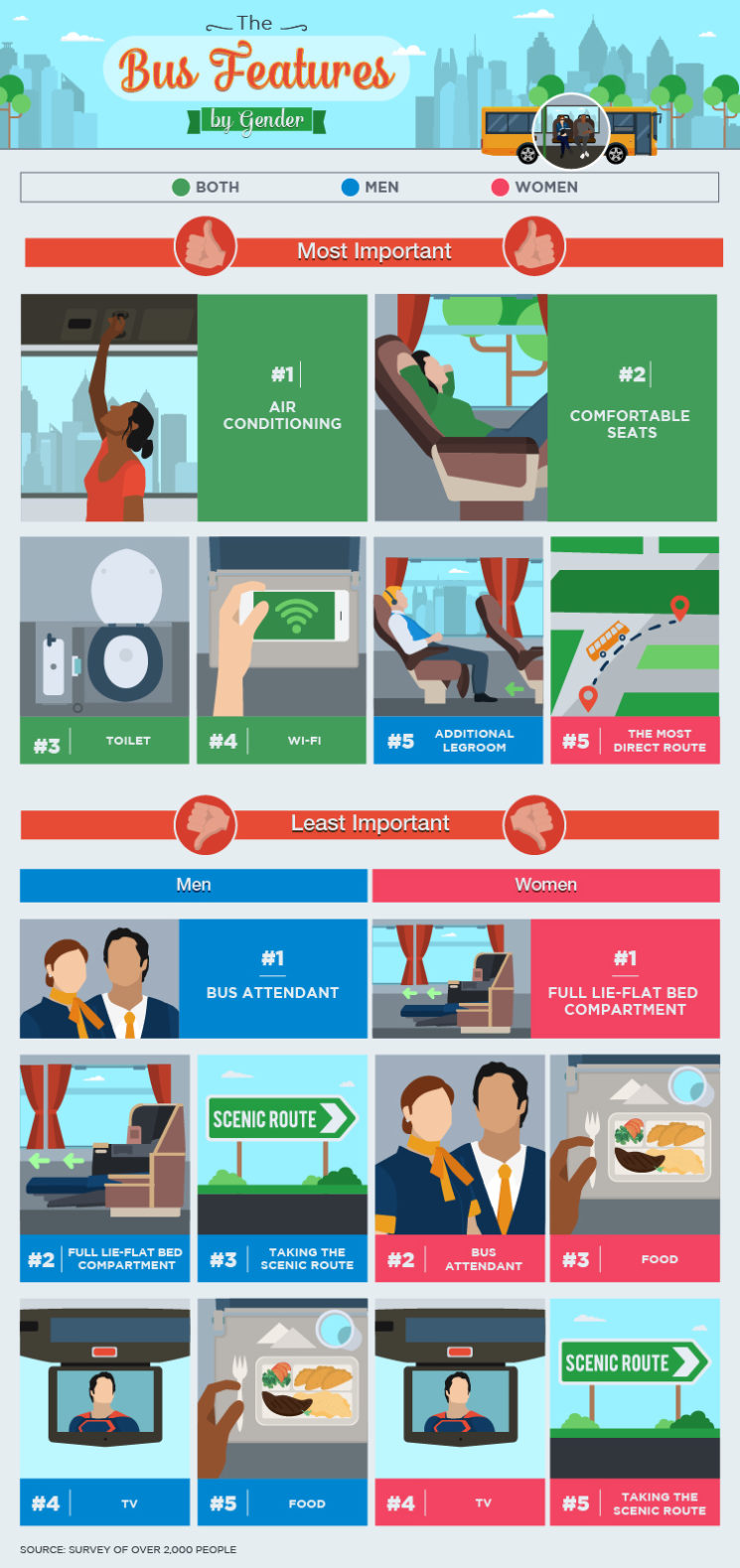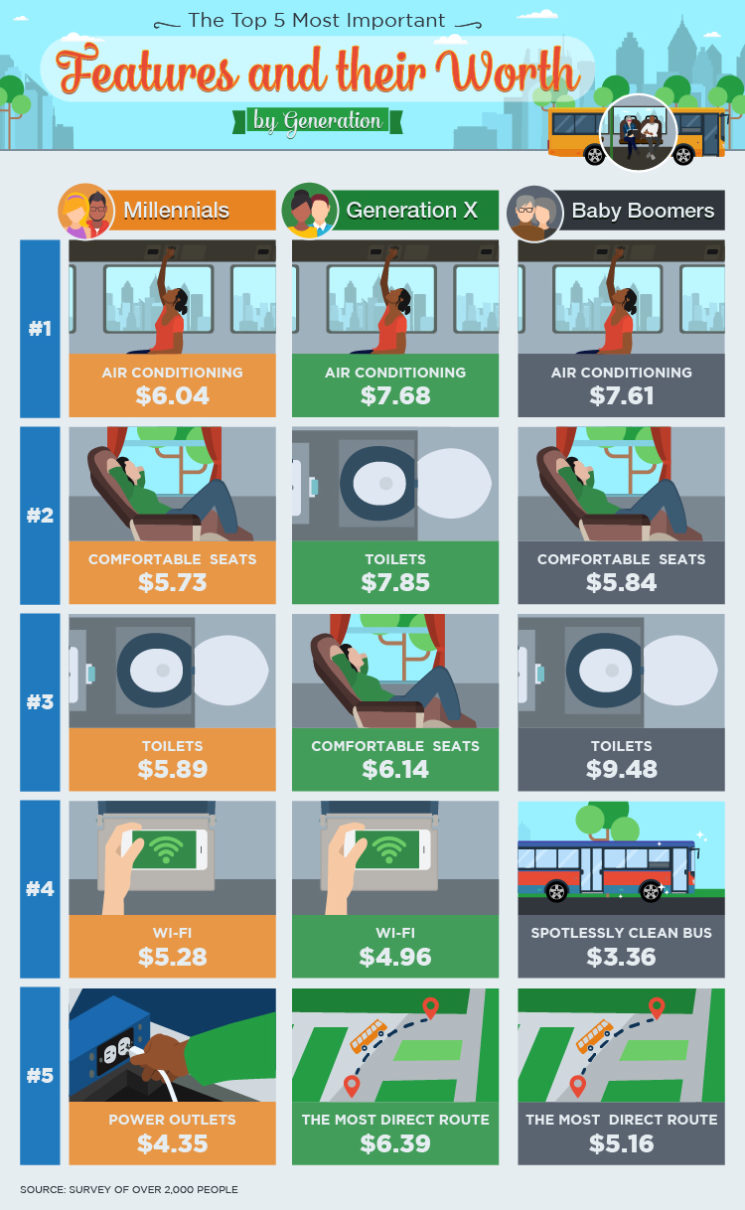There’s nothing like planning a road trip, packing for your adventure, and knowing you get to soak up the views of the road without having to log any of the hours driving.
But when it comes to taking the bus, not all rides are created equal. From Wi-Fi and power outlets to seats that let you lay flat during the ride and refreshments on the journey, upgraded amenities can take an average bus ride from a standard trip to something worth bragging about.
At Busbud.com, we surveyed over 2,000 people to determine the features most important to travelers when taking the bus, the least important features, and what passengers are willing to shell out extra cash for. If you’re planning your next road trip, continue reading to discover all the ways you can upgrade your ride.
Necessary Bus Amenities

When ranked on a scale of one to seven, there were no two ways about it – air conditioning was the most important feature on a bus trip, according to our travelers. Rated 6.12 for importance, air conditioning might be one of the biggest differences between the trip of a lifetime and a lifetime of regret.
Comfortable seats were also a top priority (rated a six) and having a usable toilet was third. There really isn’t anything worse than stiff seats and back pain after a long journey, except perhaps having to hold in a bathroom break along the way.
While these things may be nice, a direct trip (with no stops) was the No. 1 amenity people were willing to pay extra for. On average, travelers indicated that a non-stop route would be worth almost $7.50 extra on top of the standard fare. A full compartment passengers can lie flat in was another popular nicety worth almost $6.80 more, and a useable toilet was worth almost an additional $6.70.
Thanks, but no thanks

You can’t always have everything you want in life, and travel is no exception. Sometimes, you have to prioritize what’s more important to you and let go of the rest. When it came to giving up upgraded amenities for the features they couldn’t live without, over 41 percent of bus riders told us they were willing to give up a full lie-flat bed compartment. While lying down might be nice on some trips, a comfortable seat or a place to go to the bathroom was more important.
Travelers also told us they would be happy to pass on a bus attendant if it meant they could have one of their top-rated features, and taking the scenic route was an easy skip for things like extra leg space or power outlets.
His and Her Bus Preferences

When it came to the most important aspects of traveling by bus, men and women (mostly) agreed on their top-rated priorities.
Air conditioning, comfortable seats, a toilet, and Wi-Fi were equally rated as non-negotiable necessities when taking a bus ride. However, men told us that additional legroom was on their top-five list, while women opted for the most direct route to round out their most important accommodations.
When it came to the least important elements of their road trip by bus, men told us that a bus attendant was the No. 1 thing they could do without. However, on the other side of the aisle, women said that a full lie-flat bed compartment was the least important thing on their travels. Both identified TV, food, and taking the scenic route as amenities for which they wouldn’t consider paying extra.
Generational Bus Upgrades

Regardless of age, the most important convenience for those traveling by bus was air conditioning. Millennials, Gen Xers, and baby boomers agreed that the opportunity to have cool air on a long bus ride was their top must-have. When it came to what they’d pay for it, Gen Xers told us air conditioning was worth the most to them at just shy of $7.70.
Interestingly, millennials were willing to spend the least of any generation for the amenities that mattered most to them while traveling by bus, averaging just $5.45 for their top five most important features. While they were the only generation to list power outlets as a necessary feature, it was the aspect of travel they were willing to pay the least for ($4.35).
However, baby boomers and Gen Xers were willing to spend the most in addition to their fare to ensure toilets on the journey. While this was worth just under $8 for Gen Xers, baby boomers were willing to pay almost $9.50 to ensure they could use the restroom at their leisure.
Bus Wants and Needs

When it came to tech upgrades on buses, Generation Xers were more inclined to favor features like TV, Wi-Fi, and high-speed Wi-Fi, along with millennials who were the only generation to tell us that having power outlets was an upgrade worth paying for.
Seating-based upgrades were mostly important to baby boomers and those in the marketing and advertising industry as well as manufacturing. They identified comfortable chairs, business class–sized seats, and full lie-flat bed compartments as some of the most important features when traveling by bus.
Those in the real estate business, however, had the most necessary upgrades and needed features like a spotlessly clean bus, a station to wait inside before taking off, a toilet, and additional legroom for the journey.
Best Bets on Bus Travel
When it comes to bus travel – every rider has his or her preferences. From Wi-Fi and power outlets to toilets and comfy seats, most of our travelers (regardless of age or gender) told us how important these features were. Of course, the most popular amenity of all was air conditioning.
When you’re planning your next bus trip, let Busbud.com help you find the features that matter most. Whether that’s food and a TV or a bus attendant to keep you comfy during the ride, Busbud lets you search hundreds of different companies in 10,000 cities across 63 different countries and over 500,000 bus routes to find the perfect trip for you. Don’t sacrifice the amenities you care about or pay extra for the ones you don’t. Visit Busbud to start planning your next adventure today.
Methodology
We surveyed 2,009 people about their bus travel preferences.
Fair Use Statement
If you’d like to cover our findings on the top bus features for noncommercial use, make sure to feature a link back to this page.